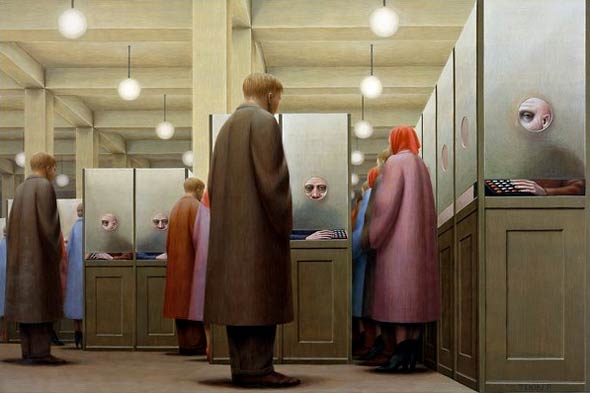
I was in the middle of teaching the difference between knowledge and belief when my cell phone buzzed in my pocket. It was a call from the dean of the University of Nevada, Las Vegas College of Liberal Arts.
The dean informed me that he was very sorry but, barring an unlikely immediate solution to the state’s financial crisis, the university had decided to eliminate the Philosophy Department, which I chair.
In July, I would be given a one-year terminal contract. After that, the university would fire me, along with all of my departmental colleagues, after twenty years of service.
{ The Boston Review | Continue reading }
economics, ideas, vegas |
April 6th, 2011

In a closely-watched oral argument Monday at a federal courthouse in Washington, the core questions of the case read like scripts from a college philosophy exam: are isolated human genes and the subsequent comparisons of their sequences patentable? Can one company own a monopoly on such genes without violating the rights of others? They are multi-billion dollar questions, the judicially-sanctioned answers to which will have enormous ramifications for the worlds of medicine, science, law, business, politics and religion.
Even the name of the case at the U.S. Circuit Court for the Federal Circuit — Association of Molecular Pathology, et al. v United States Patent and Trademark Office, et al — oozes significance. The appeals court judges have been asked to determine whether seven existing patents covering two genes — BRCA1 and BRCA2 (a/k/a “Breast Cancer Susceptibility Genes 1 and 2″) — are valid under federal law or, instead, fall under statutory exceptions that preclude from patentability what the law identifies as ”products of nature.”
In other words, no one can patent a human being. Not yet anyway.
{ The Atlantic | Continue reading }
painting { Jenny Saville, Plan, 1993 }
economics, genes, law |
April 6th, 2011

As of 2009 there were 3,020 museums in China, including 328 private museums (the American Association of Museums estimates 17,500 in the US). One hundred new museums are being added each year. In March the government made entry to museums of modern and contemporary art free. The torrid pace of museum development is part of a national drive to build cultural infrastructure and, as Cai Wu, the minister of culture, put it earlier this year in a published comment, “to establish a batch of world-famous cultural brands.”
“The next ten years should be a golden period for the development of every aspect of cultural industries in China,” said Ye Lang. “The country isn’t just satisfied with the economic achievements it had made,” the Xinhua news agency announced in January. “What it now needs is all-round cultural influence on an international scale.” The government backs these ambitions with a cultural outlay of $4.45bn in 2009, excluding construction costs.
{ The Art Newspaper | Continue reading }
photo { Mike Osborne }
art, asia, economics |
April 6th, 2011
sport, visual design |
April 6th, 2011

Alvin Roth spent years writing academic papers about the medical job market — specifically, picking apart the national system that matched young doctors to their first hospital jobs out of medical school. (…)
When it was introduced in the 1950s, the National Resident Matching Program was supposed to help doctors with the stressful and chaotic problem of finding their hospital internships. But after four decades, it was showing its age. Some medical students complained that the process was unfair, and that hospitals were being given too much power in determining where new doctors would live and work. Above all, the system was faltering because it was designed at a time when virtually no women became doctors, which meant it couldn’t handle married couples applying simultaneously. The result was that young doctors were passing up job opportunities for family reasons, and in some cases husbands and wives were assigned to distant cities and asked to choose their careers over each other.
As a professor who specialized in game theory, Roth had been studying medical matching programs closely since the early 1980s, figuring out what worked and what didn’t, and what rules were required to make a system in which everyone — the hospitals, the doctors — ended up happiest. He had coauthored a book full of theories and equations related to the problem of matching in general. He was so well known for this, one colleague remembers, that medical students would call him every year for advice on how to game the system. (…)
Roth has emerged as a rare figure in the academic world: a theorist willing to dive into real-world problems and fix them. After helping the med students, he designed a better way to assign children to public schools — the system now used by both Boston and New York. He also helped invent a system for matching kidney donors with patients, dramatically increasing the number of donations that take place each year.
{ The Boston Globe | Continue reading }
U.S., economics, health, ideas |
April 6th, 2011

An examination of emotions reported on 12 million personal blogs along with a series of surveys and laboratory experiments shows that the meaning of happiness is not fixed; instead, it systematically shifts over the course of one’s lifetime. Whereas younger people are more likely to associate happiness with excitement, as they get older, they become more likely to associate happiness with peacefulness. This change appears to be driven by a redirection of attention from the future to the present as people age. The dynamic of what happiness means has broad implications, from purchasing behavior to ways to increase one’s happiness.
{ The Shifting Meaning of Happiness/SAGE | Continue reading }
photo { Rachel Styer }
psychology |
April 5th, 2011

Research by McGill Sociology Professor Eran Shor, working in collaboration with researchers from Stony Brook University, has revealed that unemployment increases the risk of premature mortality by 63 per cent. Shor reached these conclusions by surveying existing research covering 20 million people in 15 (mainly western) countries, over the last 40 years.
One surprising finding was that (…) the correlation between unemployment and a higher risk of death was the same in all the countries covered by the study. (…)
The research also showed that unemployment increases men’s mortality risk more than it does women’s mortality risk (78 per cent vs. 37 per cent respectively).
{ EurekAlert | Continue reading }
painting { George Tooker, Painter Capturing Modern Anxieties, Dies at 90 }
economics, health |
April 5th, 2011
visual design |
April 4th, 2011

What all media, all representations—from street signs to photographs to emoticons—have in common is this: they pay attention to you, they address you. Sometimes generically, as with street signs, sometimes precisely, as with person-specific ring tones. And all that attention is flattering—indeed, it is a form of flattery so pervasive, and so essential to the nature of representation, that it has escaped notice as such, though it ultimately accounts for the oft-remarked narcissism of our time. The very process by which reality and representation become fused in the age of the simulacrum is delivered to our psyches by the flattery of representation. We have been consigned by it to a new plane of being, a new kind of life-world, an environment of representations of fabulous quality and inescapable ubiquity, a place where everything is addressed to us, everything is for us, and nothing is beyond us anymore. (…)
In a mediated world, the opposite of real isn’t phony or artificial—it’s optional.
{ On the Politics of Pastiche and Depthless Intensities: The Case of Barack Obama | Institute for Advanced Studies in Culture | Continue reading }
photo { Todd Fisher }
ideas |
April 4th, 2011

{ Fukushima Fallout Reaches San Francisco. Small amounts of radioactive material have turned up in rainwater in the Bay Area, say nuclear scientists. | The Physics arXiv Blog | full story | Read more: The Bulletin of the Atomic Scientists | Fukushima in focus: collection of coverage }
artwork { Ruel Pascual }
U.S., asia, incidents, uh oh |
April 4th, 2011

{ Map: A modern redrawing of the 1807 version of the Commissioner’s Grid plan for Manhattan, a few years before it was adopted in 1811. Central Park is absent. | Two hundred years ago on Tuesday, the city’s street commissioners certified the no-frills street matrix that heralded New York’s transformation into the City of Angles — the rigid 90-degree grid that spurred unprecedented development, gave birth to vehicular gridlock and defiant jaywalking. Today, debate endures about the grid, which mapped out 11 major avenues and 155 crosstown streets along which modern Manhattan would rise. | NY Times | full story | Interactive map: How Manhattan’s Grid Grew }
related { New York didn’t invent the apartment. Shopkeepers in ancient Rome lived above the store, Chinese clans crowded into multistory circular tulou, and sixteenth-century Yemenites lived in the mud-brick skyscrapers of Shibam. But New York re-invented the apartment many times over, developing the airborne slice of real estate into a symbol of exquisite urbanity. Sure, we still have our brownstones and our townhouses, but in the popular imagination today’s New Yorker occupies a glassed-in aerie, a shared walk-up, a rambling prewar with walls thickened by layers of paint, or a pristine white loft. | NY mag | full story }
new york |
April 4th, 2011

The principle of Feng shui - to arrange rooms and buildings in ways that are pleasing and health-giving - has popular appeal. Unfortunately, Feng shui’s scientific credentials are lacking, being based as it is on the ancient Chinese concept of Ch’i or life-force. The good news is that psychologically informed, evidence-based design is on the increase. Consider this new study by Sibel Dazhir and Marilyn Read, which has compared the effects of curvilinear (rounded) and rectilinear (straight-edged) furniture on people’s emotions. (…)
The two room versions full of curvilinear furniture provoked significantly higher pleasure and approach ratings from the students. (…) It’s worth considering whether rectilinear-themed rooms may have their own benefits for purposes other than relaxing and socializing.
{ BPS | Continue reading }
interior { Chad McPhail }
guide, psychology, visual design |
April 4th, 2011

{ $1,700: The annual benefit the average American derives from personal computers. | WSJ | full story }
U.S., economics, technology |
April 4th, 2011

If you can be sure of one thing, then surely it is that you exist. Even if the world were a dream or a hallucination, it would still need you to be dreaming or hallucinating it. (…)
There is a wide range of scientific evidence that is used to deny “I think, therefore I am”. In René Descartes’ famous deduction, a coherent, structured experience of the world is inextricably linked with a sense of a self at the heart of it. But as the clinical neuropsychologist Paul Broks explained to me, we now know the two can in fact be separated.
People with Cotard’s syndrome, for instance, can think that they don’t exist, an impossibility for Descartes. Broks describes it as a kind of “nihilistic delusion” in which they “have no sense of being alive in the moment, but they’ll give you their life history”. They think, but they do not have sense that therefore they are.
Then there is temporal lobe epilepsy, which can give sufferers an experience called transient epileptic amnesia. “The world around them stays just as real and vivid – in fact, even more vivid sometimes – but they have no sense of who they are,” Broks explains. This reminds me of Georg Lichtenberg’s correction of Descartes, who he claims was entitled to deduce from “I think” only the conclusion that “there is thought”. This is precisely how it can seem to people with temporal lobe epilepsy: there is thought, but they have no idea whose thought it is.
{ The Independent | Continue reading }
photo { Noritoshi Hirakawa }
ideas, psychology |
April 2nd, 2011

In the 2006 movie, Borat: Cutural Learnings of America for Make Benefit Glorious Nation of Kazakhstan, English comedian Sacha Baron Cohen plays the role of an outrageously inappropriate Kazakh television reporter who journeys across the United States to film a documentary about American culture. In the course of his travels, the title character uses his bizarre persona to elicit offensive statements and behavior from, as well as to generally humiliate, a number of ordinary Americans who are clearly not in on the joke. How did the producers convince these unfortunate stooges to participate in the project? According to several who later sued, the producers lied about the identity of Borat and the nature of the movie when setting up the encounters in advance over the telephone, and they then contradicted and disclaimed the lies in a waiver that the stooges signed without reading just before the cameras began to roll.
This talk article explains the doctrinal and normative reasons that the Borat problem, which arises frequently, although usually in more mundane contexts, divides courts. It then suggests an approach for courts to use when facing the problem that minimizes risks of exploitation and costs of contracting.
{ The ‘Borat’ Problem and the Law of Negotiation | Continue reading }
photo { Alpines, the Night Drive EP, 500 individually numbered 10″ Vinyl Discs }
ideas, law, showbiz |
April 2nd, 2011

The upper 1 percent of Americans are now taking in nearly a quarter of the nation’s income every year. In terms of wealth rather than income, the top 1 percent control 40 percent. Their lot in life has improved considerably. Twenty-five years ago, the corresponding figures were 12 percent and 33 percent. One response might be to celebrate the ingenuity and drive that brought good fortune to these people, and to contend that a rising tide lifts all boats. That response would be misguided. While the top 1 percent have seen their incomes rise 18 percent over the past decade, those in the middle have actually seen their incomes fall. For men with only high-school degrees, the decline has been precipitous—12 percent in the last quarter-century alone. All the growth in recent decades—and more—has gone to those at the top. In terms of income equality, America lags behind any country in the old, ossified Europe that President George W. Bush used to deride. Among our closest counterparts are Russia with its oligarchs and Iran.
{ Vanity Fair | Continue reading }
photo { Keith Arnatt }
U.S., economics |
April 2nd, 2011
photogs |
April 2nd, 2011

During the late Victorian period British women maintained a significant numerical advantage over men such that “almost one in three of all adult women were single and one in four would never marry.” Therefore it is no coincidence that spinsters “provided the backbone” of the women’s suffrage movement in the late nineteenth and early twentieth century. These spinster-led feminists opposed patriarchal exploitation and challenged “the idea that male sexuality was a powerful and uncontrollable urge,” and in the course of their activism drew much needed attention to other related problems such as prostitution and the abuse of girls. But by presenting such resistance to the status quo their rising success roused an equally powerful countervailing enemy whose rise to power was intimately connected to the proponents of the “sexual revolution” that came to fruition in the 1920s.
{ Swans| Continue reading }
flashback, ideas, relationships |
March 31st, 2011

The annals of business history are full of tales of companies that once dominated their industries but fell into decline. The usual reasons offered don’t fully explain how the leaders who had steered these firms to greatness lost their touch.
In this article we argue that success can breed failure by hindering learning at both the individual and the organizational level. We all know that learning from failure is one of the most important capacities for people and companies to develop. Yet surprisingly, learning from success can present even greater challenges.
{ Harvard Business Review | Continue reading }
photo { Horace Vernet, Mazeppa and the Wolves, 1826 }
economics, ideas |
March 31st, 2011

I have always suffered with having a (my girlfriend calls it) gi-normous penis. Imagine have two soda cans duct tapped together in your pants. I have always had a hard time sitting down and forget about it if I have an erection. (…) Have you ever been asked to GO HOME from your boss because you were distracting co-workers?
{ Amazon.com | Comments }
books, haha |
March 31st, 2011






















